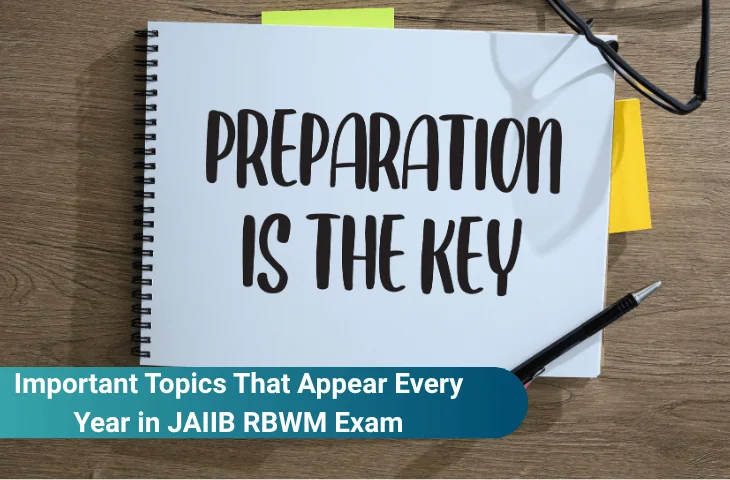The JAIIB (Junior Associate of the Indian Institute of Bankers) exam is one of the most critical exams for banking professionals aiming to advance their careers in retail banking, credit, and financial management. As per the official notice, the JAIIB November 2025 exam is scheduled to start from 2nd November and the RBWM paper is going to be held on 16th November, giving aspirants roughly one month to prepare.
If you are appearing for the JAIIB November exam, revising high-frequency topics that repeatedly appear in past exams can give you a significant advantage. Based on previous cycles and expert analysis, certain chapters have consistently contributed 30–35 marks in each attempt.
In this blog, we provide a detailed breakdown of must-know topics for JAIIB, module-wise, so that you can focus your preparation strategically.
Important JAIIB RBWM Topics
Some of the most repetitive topics for the JAIIB RWM paper are as follows:
| Module | Topics & Approx. Marks |
| Module A – Basics of Retail Banking | • Retail Banking: Introduction • Branch Profitability • Application of Retail Banking Marks: 10 |
| Module B – Customer & Product Management | • Customer Requirements • Product Development Process • Credit Scoring • Retail Liability Products • Retail Asset Products • Credit & Debit Cards • Remittance Products • Digitalization of Retail Banking Products • Role of AI & Technology • Recovery of Retail Loans Marks: 30–35 |
| Module C – Delivery Channels & Service Standards | • Delivery Channels in Retail Banking • Delivery Models • Service Standards for Retail Banking Marks: 20–25 |
| Module D – Investment & Tax Planning | • Wealth Management • Investment Management • Tax Planning Marks: 20–25 |
| Home Loans | • Lender’s Appraisal Procedure (Theory) • Housing Finance & Tax Planning (Theory) • Mortgage Advice (Numerical) • Valuation of Real Property (Theory + Numerical) Marks: 10–15 |
JAIIB RBWM Exam Pattern
The JAIIB RBWM Exam 2025 is conducted in an online mode with no negative marking. The paper consists of 100 questions for 100 marks, and candidates are given 2 hours to complete the paper. After final submission candidates will get to know the total correct answers, they have marked in the paper. The details of the JAIIB exam pattern are as follows:
| Feature | Details |
| Total Questions | 100 objective-type MCQs per paper |
| Total Marks | 100 marks per paper |
| Case-Based Questions | Yes, included in all subjects |
| Exam Mode | Online (CBT) |
| Negative Marking | No negative marking |
| Assessment Areas | Basic knowledge, application skills, case handling, and numerical aptitude |
Also Check: JAIIB RBWM Detailed Syllabus
Module-wise Breakdown of Important Topics
The module-wise details of the important topics for the JAIIB RBWM paper are as follows:
Module A: Basics of Branch Banking
Module A covers the core concepts of banking, including retail and branch operations. Focusing on these ensures that you secure easy marks through direct questions.
| Topic | Description | Approx. Marks |
| Retail Banking | Definitions, differences between retail and wholesale banking; key applications | 2–3 |
| Branch Profitability | Gross profit, ROA, leverage ratios; critical for Model A questions | 3–4 |
| Application of Retail Banking Models | Practical application in real banking scenarios; often tested in case studies | 2–3 |
Also Check: JAIIB Admit Card 2025
Module B: Customer Requirements & Products
This module covers customer-centric banking and product development. Questions often appear from customer segmentation, Maslow’s theory, and product development stages (PDLS).
| Topic | Description | Approx. Marks |
| Customer Requirement & CRM | Maslow theory, customer segmentation; high-relevance topics | 3–5 |
| Product Development Stages (PDLS) | Introduction, growth, and maturity stages; always tested | 3–4 |
| Retail Liabilities | Savings account, current account, types of deposits; essential | 2–3 |
| Loans | Home and education loans; highly likely to appear | 3–4 |
| Credit/Debit Cards | Key features and uses; recurring questions | 2 |
Module C: Delivery Channels & Digital Banking
Module C focuses on digital banking and delivery mechanisms. Questions often cover ATMs, online transactions, and remittance products.
| Topic | Description | Approx. Marks |
| Delivery Model | ATM, DBS model, delivery channels; repeated in exams | 2–3 |
| Digital Banking Products | IBRT, NFS, NEFT/RTGS, ACS; very likely to appear | 3–4 |
| Retail Loan Recovery | SARFAESI, DRT, Lok Adalat; often tested | 3–4 |
| NPA Management | Key definitions, provisions, and reporting | 2 |
Module D: Investment, Insurance & Taxation
Module D covers investment products, insurance services, taxation, and budget planning. These topics are formulaic and calculation-based, often contributing significantly to your score.
| Topic | Description | Approx. Marks |
| Portfolio Management & PMS | Investment models, bonds, mutual funds; high-yield topic | 3–4 |
| Budget & Text Planning | Bank’s budget, social schemes, new policies; targeted questions | 2–3 |
| Insurance Products | PMJJBY, PMSBY, sovereign gold bonds; expected questions | 2–3 |
| Reverse Mortgage Loan | Frequently asked in recent exams; numerical-based | 2–3 |
| NUT & Present/Future Value | Calculation-based questions; crucial for marks | 3–4 |
| Tax & 80C/80EE | Income tax deductions; moderate difficulty but recurring | 2–3 |
Last Minute Preparation Strategy
The last-minute preparation strategy for the JAIIB RBWM paper is as follows:
- Focus on High-Weightage Topics First – Prioritize Modules B and D; these cover the bulk of marks.
- Practice Numericals & Formulas – Module D topics often involve calculations; practice thoroughly.
- Revise Previous Year Questions – Look at memory-based papers from May 2025 and October 2024 for trends.
- Use Downloadable Notes/PDFs – Helps in quick revision during travel or offline study.
- Mock Tests – Attempt both module-wise and full-length mocks to gauge timing and accuracy.
JAIIB RBWM Memory-Based Questions
Q1. Which of the following is an essential requisite of a Mortgage by Deposit of Title
Deeds under the Transfer of Property Act?
- Transfer of possession of the property
- Registration of the mortgage deed
- Delivery of title documents with intent to create a security
- Mortgagee can sell the property without court intervention
Correct Answer: C) Delivery of title documents with intent to create a security
Q2.Which of the following statements regarding priority of mortgages are true?
- A simple mortgage takes precedence over an equitable mortgage in case of dispute.
- The first registered mortgage holds priority over a subsequent equitable mortgage.
- An equitable mortgage created before a registered mortgage will still have priority over the
registered mortgage. - The mortgagee in an equitable mortgage cannot enforce their rights if they lose possession
of title deeds.
- Only 1 and 3
- Only 2 and 4
- Only 3 and 4
- All of the above
Correct Answer: C) Only 3 and 4
Q3. Which of the following assets qualify as long-term capital assets when held for
more than 12 months?
- Equity shares listed on a recognized stock exchange
- Units of equity-oriented mutual funds
- Unlisted corporate bonds
- Zero-coupon bonds
- Only 1 and 2
- Only 1, 2, and 4
- Only 1 and 4
- All of the above
Correct Answer: B) Only 1, 2, and 4
Q4. Which of the following statements about CRM implementation in retail banking
are correct?
- Business process evaluation is necessary to align CRM with product offerings and customer
portfolio management. - CRM implementation does not require restructuring of existing information processes in the
bank. - Legacy IT systems must be carefully integrated rather than replaced to ensure smooth CRM
adoption. - Organizational culture plays a crucial role in CRM acceptance and responsiveness.
- Only 1 and 3
- Only 1, 3, and 4
- Only 2 and 4
- All of the above
Correct Answer: B) Only 1, 3, and 4
Q5. Which of the following statements about branch profitability are correct?
- Branch profitability depends on revenue generated, operating costs, and risk exposure.
- A bank’s efficiency in loan recovery impacts its branch profitability.
- Higher employee costs always indicate reduced profitability in branch operations.
- Profitability analysis helps banks decide on branch expansion strategies.
- Only 1 and 2
- Only 1, 2, and 4
- Only 2 and 3
- All of the above
Correct Answer: B) Only 1, 2, and 4
Key Takeaways
| Module | Important Topics | Minimum Marks in Exam | Notes |
| A | Retail Banking, Branch Profitability | 7–8 | Repeatedly asked; easy to score |
| B | Customer Requirement, PDLS, Retail Liabilities, Loans | 12–13 | Must focus; moderate effort |
| C | Delivery Channels, Digital Banking, Loan Recovery | 10 | Recurrent; case-based and conceptual |
| D | Investments, Insurance, Tax, Reverse Mortgage Loan | 15 | Formulaic; high-yield |
FAQs
Together, these topics cover approximately 30–37 marks. Including a few additional subtopics, you can target 50 marks confidently.
Yes, you can prioritize high-weightage topics first and prepare minor topics partially (60–70%).
Focus on understanding derivations and logic rather than rote memorization. Reverse mortgage, NUT, and investment calculations need practice.
Yes, they are part of Module B and frequently appear in questions.
Lender’s Appraisal Procedure, Housing Finance & Tax Planning, Mortgage Advice, and Valuation of Real Property.
- 3 Common Mistakes to Avoid While Preparing for JAIIB Exam
- JAIIB RBWM Exam 2025 Analysis 16th November 2025
- Difference Between JAIIB & CAIIB, Eligibility, Exam Pattern
- JAIIB AFM Exam Analysis 2025, 9th November All Shifts Review
- JAIIB PPB Exam Analysis 2025, 8th November All Shifts Review
- JAIIB Exam Analysis 2025, November Cycle, All Shifts Covered

Hi, I’m Aditi. I work as a Content Writer at Oliveboard, where I have been simplifying exam-related content for the past 4 years. I create clear and easy-to-understand guides for JAIIB, CAIIB, and UGC exams. My work includes breaking down notifications, admit cards, and exam updates, as well as preparing study plans and subject-wise strategies.
My goal is to support working professionals in managing their exam preparation alongside a full-time job and to help them achieve career growth.
